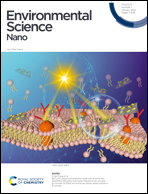Transformation of carbon dots by ultraviolet irradiation, ozonation, and chlorination processes: kinetics and mechanisms†
Abstract
As a new carbon nanomaterial, carbon dots (CDs) with unique physicochemical and luminescence properties have wide-ranging applications. Once released into water and wastewater treatment plants, CDs will undergo physicochemical transformations due to exposure to disinfection treatments. The present study examined the transformations of CDs under three typical disinfection treatments including ultraviolet (UV) irradiation, ozonation, and chlorination. Our results indicated that CDs can be degraded efficiently by UV irradiation, ozonation, and chlorination, implying the fundamental role of oxygen and chlorine related radicals in CDs degradation. The degradation of CDs by all three treatments followed pseudo-first-order reaction kinetics. Various characterization results revealed the structural and chemical property changes of CDs after treatment by the three disinfection processes. We proposed that under reactive species attack, CDs were firstly degraded into macromolecular species and gradually cleaved into micromolecular compounds with the release of CO2. Many chlorine substitution/addition by-products were identified after the chlorination treatment of CDs, suggesting the potential negative impacts and health risks of CDs after environment-relevant transformations. The CDs degradation efficiency differed slightly at the examined pH values of 5.0–9.0. Water constituents including humic acid and anions exhibited various effects on CDs degradation in the three disinfection processes. Nevertheless, high removal efficiencies of CDs by the three disinfection processes were observed in natural water samples. The results of this study highlighted the non-negligible influence of water disinfection treatment on the fate of CDs in aquatic environments and provided a quantitative framework for evaluating the fate of CDs during disinfection/oxidation.



 Please wait while we load your content...
Please wait while we load your content...